MATTERS OF OBSESSION
How to read a Rothko painting: Up, close and personal
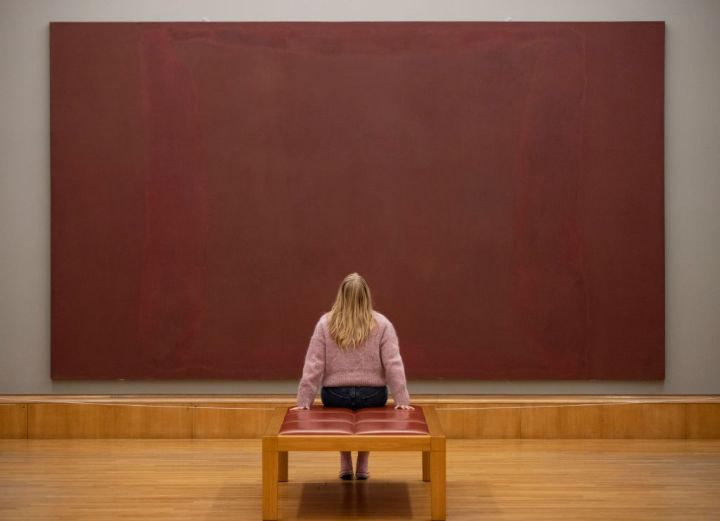
Mark Rothko’s abstract paintings can generate quite a diverse range of strong reactions of dislike, disillusionment and sheer incomprehension. Here, we argue that you have to be still, banish the critics and the academics and experience his work almost viscerally to fully engage with it.
“I don’t like Rothko”. Or, “I used to love Rothko. No More. I feel a bit like the emperor has no clothes.” Or, “I’m a little baffled by the obsession”. These are some of the popular responses to the American artist Mark Rothko defined as an abstract expressionist (a definition he refused to acknowledge) and a colour field artist. From the comments above one can see his paintings generate quite a diverse range of strong reactions of dislike, disillusionment and sheer incomprehension. And then of course there are the Rothko-ites.
It’s pointless to argue about likes and dislikes. For, like beliefs, they are subjective and best left alone. Bafflement, however, provides a possible doorway to perceptual shifts in how to read and receive Rothko’s paintings.
Rothko was many things: an artist, an intellectual who was influenced by the writing of Nietzsche, an immigrant and a pioneer.
The artist was also famous for a commission for the Four Seasons Restaurant in New York’s Seagram building in 1958, which he eventually withdrew from. His intention was twofold: First, it was against the rationality of architect Ludwig Mies van der Rohe’s building, and second, “to ruin the appetite of every son of a bitch who ever eats in that room”, with paintings that would make “those rich bastards feel that they are trapped in a room where all the doors and windows are bricked up”. He was also appalled at the price of a hamburger.
Through his ultimate withdrawal from the commission, we see Rothko as the son of an outspoken Marxist, an activist and spokesperson for the poor and oppressed.
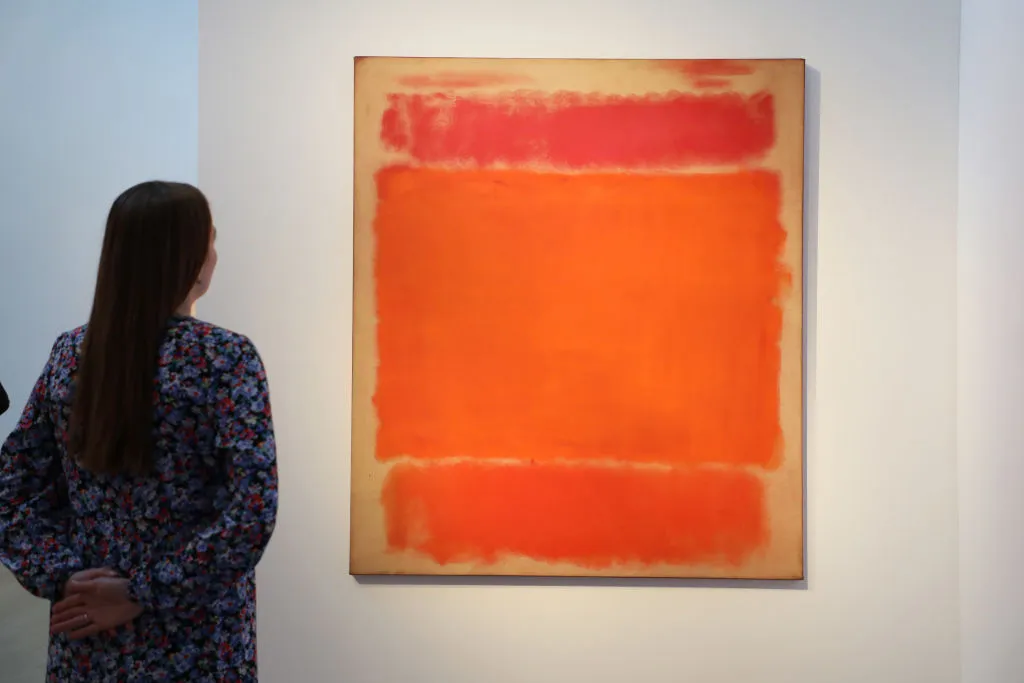
A guest views No.1 by Rothko ahead of the auction of the collection of Anne H Bass at Christie’s on April 05, 2022 in London, England. Image: Lia Toby / Getty Images
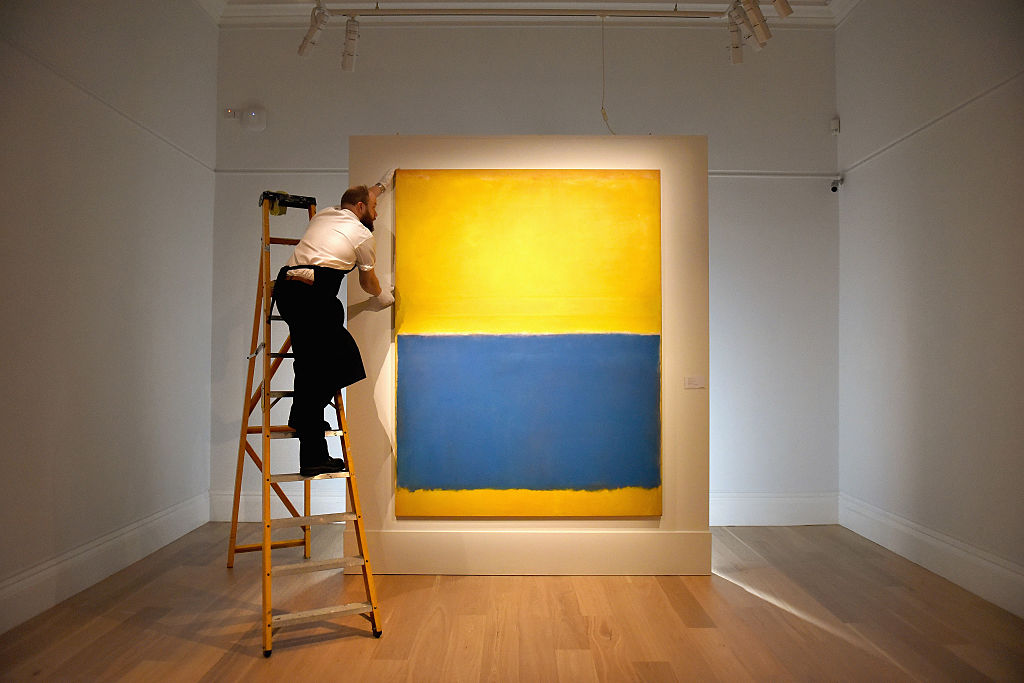
A gallery technician makes adjustments to the hanging of Mark Rothko’s ‘Untitled (Yellow and Blue), executed in 1954, as the work goes on show at Sotheby’s on April 10, 2015 in London, England. Image: Mary Turner / Getty Images for Sotheby’s
Just as Mark Rothko wasn’t always called Mark Rothko, he didn’t always paint like Mark Rothko. He was born Markus Yakovlevich Rothkowitz to Latvian immigrant parents. While his early works are seen as reflecting the zeitgeist of his time, they suggest nothing of the seismic shift ahead. And yet, although change may seem sudden, it’s often incremental, a long time in the making until suddenly it’s apparent.
Master photographer Henri Cartier-Bresson writes about the defining moment in photography: when the elements conspire at the precise moment that the photographer releases the shutter. The result is something unique and special. For Rothko, his defining moment begins when he moves from his figurative paintings of subways, hat shops, restaurants and the architecture of cityscapes, the mythological, the surreal, the fuzzy-edged multiform abstracts, to the “sectional” abstracts, or “feeling fields” or “colour states” which, like the nervous tics of his psyche, became his well-known signature.
Rothko’s shift is rooted in both the historical, such as the ancient Roman wall paintings from Boscoreale in the Metropolitan Museum of Art and the Pompeiian House of Mysteries, the work of Rembrandt and the moderns such as Henri Matisse’s The Red Studio and, of course, his contemporaries.
In her talk, “Mark Rothko: The Artist’s Reality”, for the Boston Museum of Fine Arts, academic Elliot Bostwick Davis pinpoints Rothko’s painting, Thru the Window, a self-portrait with a bright-red easel and canvas as the beginning of Rothko coming into his Rothko-essness.
Davis makes the connection with Thru the Window and a small Rembrandt self-portrait, Artist in his Studio, showing a stocky Rembrandt at a distance from a large painting on an easel. Rembrandt was one of Rothko’s heroes and he would have had access to both this particular painting and Matisse’s seminal The Red Studio, first exhibited in 1949. It’s The Red Studio that carries the seeds of something brand new to be fully realised in Rothko’s sectional “all-over paintings”. Of the painting, he said that the most amazing thing about Matisse’s work is that you become absorbed by colour. It’s a statement that carries the prophetic and not-yet-conceived colour fields. Davis points out that both Rembrandt and Rothko’s paintings draw attention to the frame. It’s what the Renaissance polymath Leon Battista Alberti instructed painters to consider – the frame of the painting as an open window.
“I’m interested only in expressing human emotion, tragedy, ecstasy, doom and so on.”
Rothko, however, flips this idea of the open-window approach on its head. His work challenges the one-point perspective of the Renaissance. In its place, there is an absence of any one focus or “all-over” painting endemic to the abstract expressionists. This is not for the sake of rebellion but rather as a vehicle to generate an immersive environment and elicit feeling states in the viewer. No 9, painted in 1949, and No 10 are regarded as breakthrough paintings where the past is left firmly behind, and Rothko becomes the painter as we know him. He once said: “I’m interested only in expressing human emotion, tragedy, ecstasy, doom and so on.”
Interestingly, at the time of his colour fields, Davis points out that the world of science had turned inward, towards discovering the invisible world under the microscope. In the same way, Rothko’s work was also tuned into the invisible of inward-feeling states made visible through scale, mark and colour.
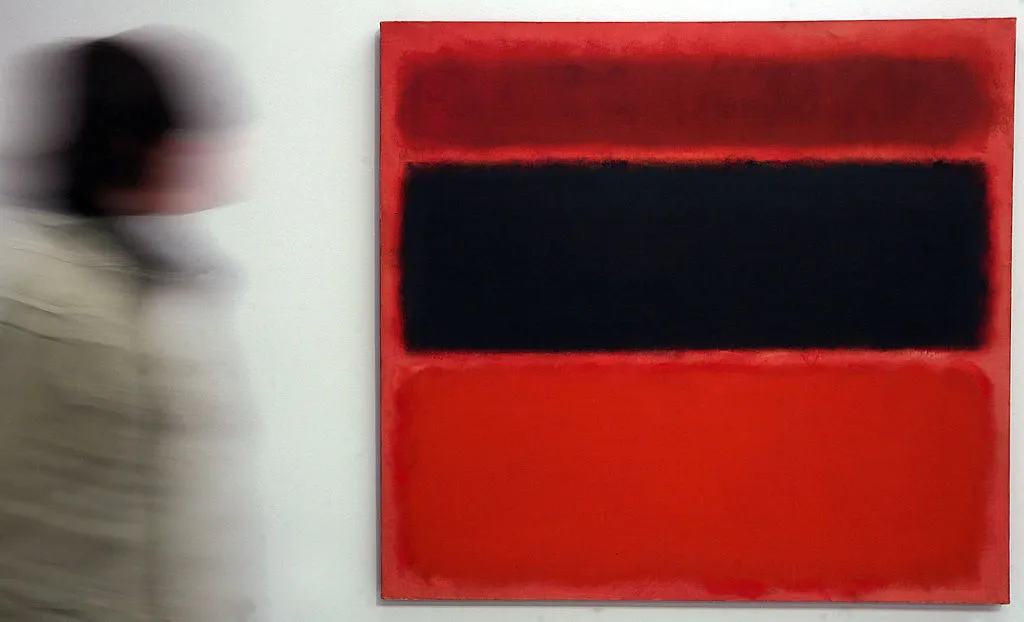
An abstract painting of US painter Mark Rothko is seen prior to the opening of an exhibition at the Munich Kunsthalle on February 7, 2008 in Munich, Germany. Image: Johannes Simon / Getty Images
So, how do you read a Rothko? Up close and very personal. Skin to skin, bare-back. There is no way around this. The presence of his works, their fugitive surfaces alive with stains, seeps, bleeds and scrapes and their structure of coloured lozenges with ragged cuticle edges evades being sealed into prophylactic reproductions. Trust this writer, when armed with the blessing of a beginner’s mind, I saw my first retrospective at the Tate Gallery and never forgot the experience.
What is fascinating was the way each room mirrored the psyche of those in it. Although the atmosphere rooms which, like temples, discouraged speaking, the body language of the viewers spoke volumes. Those with a sunny disposition congregated in the room of his yellow canvases, the melancholy in the blue room and the depressed in the aubergine one.
To receive a Rothko, you also have to be still. For, as Rothko wrote, “silence is so accurate”. Jelly down and just be in the painting’s presence. And allow. Rothko’s massive canvases, some as large as 2.4m by 3.6m, are meant to be experienced viscerally, to be engaged with the whole body, given the sheer physicality expended in creating them.

Mark Rothko’s Untitled, 1960 (Estimate: $35–50 million) goes on view at Sotheby’s on February 16, 2022 in London, England. Image: Tristan Fewings / Getty Images for Sotheby’s
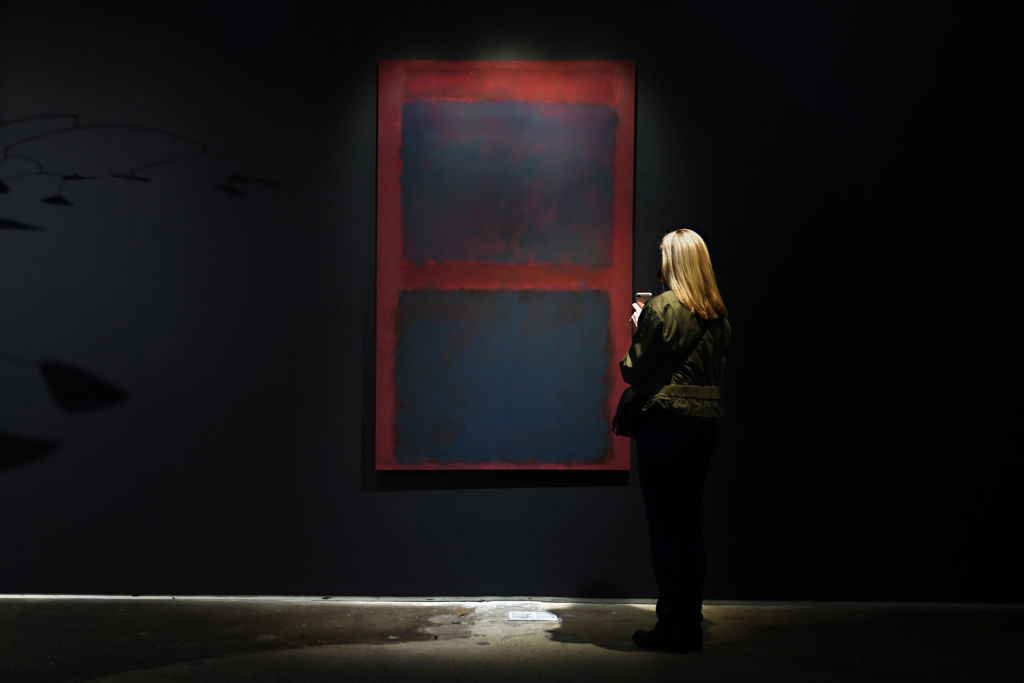
A person looks at “Untitled (Black on Maroon)” by Mark Rothko. Image: Cindy Ord / Getty Images
While Rothko understood historically that large paintings were about making grandiose statements, he turns this on its head. Size for him is the antithesis of grandiose. Instead, he uses it to create intimacy. For him a small work meant excluding the viewer’s experience whereas a large work means “you are in it, it isn’t something you command”. And here’s another flipped approach. When asked how far back the viewer should interact with the paintings, he said 45cm. That’s a very small area for a huge canvas. He reasoned that this approach allows the viewer an immersive experience, a take-me-to-church experience with our inner worlds. Painting is not about an experience at a remove, but rather it becomes the immediacy of an actual experience.
To successfully read Rothko you need to banish the critics and the academics from your response – Rothko hated them and regarded them as parasites. Here’s a word of caution from the artist to the colour theorists who mistakenly believed Rothko was one of them. There is no doubt that he was a brilliant colourist, sometimes paralleled with Titian and Giorgione without the narrative. However, Rothko considered anyone who was moved only by the colour relationships in his work to have entirely missed the point of the paintings. In his work, colour is a vehicle to give voice to feeling. To elicit a state of being and to possibly experience what the artist was experiencing or feeling when he was painting them. Rothko’s work should be less an optical experience and more an experience of tuning into one’s own inner feeling state.
You’ll also notice that rather than titling his paintings, Rothko numbered them. This is to encourage a non-prescriptive, open-ended response. They are also unframed, with the intention of eliminating the divide between them and the viewer. He shifts away from the traditional approach of frame and glass which keeps the viewer at bay. His works seem to move energetically beyond the canvas boundary and occupy the surrounding space. Likewise, deliberately placing them unusually close to the ground allows for a greater immersive and physical engagement for the viewer. Often Rothko’s works are exhibited in dimly lit rooms to intensify the flicker and flash of canvas surfaces and cut out the white noise.
Rothko’s paintings pay homage to “mystery, introspection and the solitary”. There is something Blakean about them. Rothko is in a sense a mystic like Blake who lived “not to solve the mysterious but to revel in it”, both wanting “to make it on their own terms”.
Rothko’s works hold both an expression of the artist’s inner world and the projected feeling responses of the viewer. In the words of his psychologist and writer son Christopher Rothko, they are “an invitation not to step out but to turn inward”.
So stop, be still and allow whatever arises and you will have begun the process of becoming Rothko-literate. DM/ML
In case you missed it, also read Elizabeth Vels’s retrospective, ‘A Life in Making’, served as an antidote to all that ails the world
Elizabeth Vels’s retrospective, ‘A Life in Making’, served as an antidote to all that ails the world


















 Become an Insider
Become an Insider
Quite frankly, my dear, I’d rather stare out a window, for free.
Having had the opportunity of seeing Rothko’s work at the MoMA, I was awed by the emotion that they provoke – at least for me they did. Some of his contemporaries did leave me stone cold (Jackson Pollock) but then art is very subjective and to enjoy or not is a choice.
Rothko is amazing, but I would certainly like to read about South African art scene.